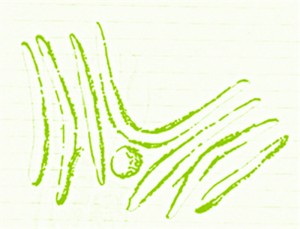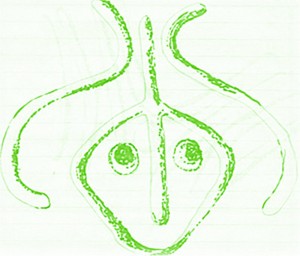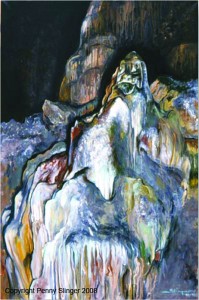
The Amerindians who settled on Anguilla found, near Shoal Bay East, a natural cavern and living cave. Known as The Fountain, the cavern has long provided a vital source of freshwater, even during periods of harshest drought for Anguillians.
The Fountain is a limestone cavern containing two freshwater pools and is a natural habitat for bats and other species. While Anguillians had always recognized the unique space, it was only after archaeologists recorded numerous glyphs (carvings) and stalactites together with pottery fragments, that the site was recognized to be a ceremonial centre for Amerindians. Several excavations at the site by archaeologists between 1986 and 2007 recovered artefacts and resulted in a complete mapping of the site.

Caves were ideologically important to the Taino who believed that all mankind originated from a cave and that the spirits of their ancestors slept inside during the day and came out as bats during the night.
For Amerindians the cosmos was divided into three spheres. It is significant that all three parts are present at the Fountain. The cavern or cave was the birthplace for humans, the pools, or subterranean waters, were where the ancestors’ spirits lived and looking up through the natural skylight, one can see the sky or dwelling place of the gods.

An Anguillian told me that when he was a child and went to The Fountain to collect water, he never explored the cavern beyond the 1st pool. He spoke with a reverence for the site and explained that he had not been surprised when archaeologists discovered evidence for Amerindian ceremonies and worship.
When archaeologists discovered Amerindian petroglyphs and carvings at the site in 1979, and the Anguilla government learned of its significance to regional pre-historic archaeology, protective legislation was passed. At the time, the property was privately owned, but after negotiations the land was purchased by the government of Anguilla to become a National Park.

Anguillians and archaeologists have both recognized the huge potential of the site. After the site’s importance became known to the public, rumours grew that one of the site’s main features (a ‘Queens Head’) had been sawn off from a stalagmite and sold for a fortune off-island. Others, including members of the original survey team, disagree that the site was ever looted. As the crime was allegedly committed before an accurate inventory was made, it is impossible to confirm or discredit the accusations.
Amidst growing concerns that the site’s main petroglyph of the Amerindian god Jocahu would be destroyed, the Anguilla National Trust decided to close The Fountain and bar all access. To that end, an iron gate was constructed over the opening. According to local reports, the bars were largely ineffective and locals continued to visit the site illegally for several years. In 2005, additional bars were added by the National Trust. However, in 2011, these too had been broken to allow illicit access. While the site is undoubtedly a significant Amerindian site with the potential to become a listed World Heritage site, it has significance to both Anguillians and archaeologists.
The Fountain was included in 1999 on the Tentative List for World Heritage Sites. The proposal reveals that the site, used between 400-1200AD is the longest used ceremonial cave site in the entire Caribbean and represents an extraordinary example of Amerindian cultural heritage.
While Anguillians have been frustrated that the site has been closed for many years, the majority recognize it as a truly unique and important part of local history. Anguillians’ connection to the past extends beyond their colonial forbears. The Fountain has a spiritual value for modern Anguillians, especially as a way for them to understand a people who shared their island (including its trials and tribulations) but whom they never met.








